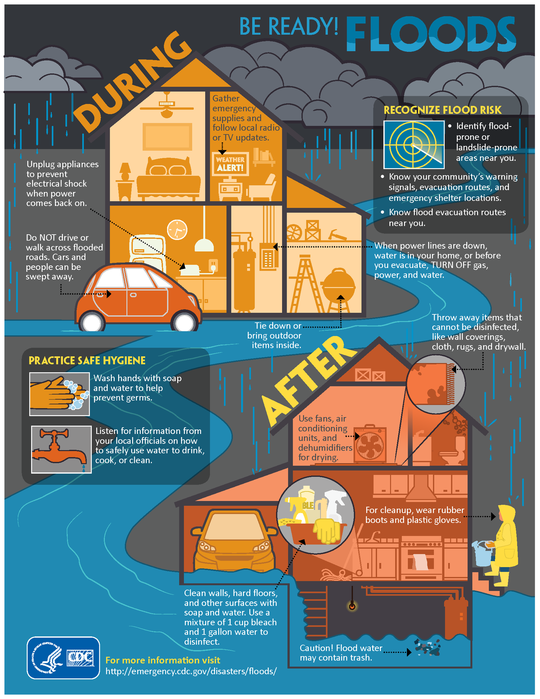02/08/2019 | Flood Warning - Ottawa County
The National Weather Service has issued a Flood Warning on Friday, February 8, 2019 for the Grand River in Kent and Ottawa County. No widespread flooding is expected. The low line flooding may cause 3"-6" in river rise today through Monday, February 11, 2019. Ottawa County Emergency Management is working with isolated communities that may be effected (such as Robinson Township, Ottawa County).
Media contact:
Nick Bonstell, Director
Ottawa County Emergency Management
616-638-7760, Nbonstell@miottawa.org
Ottawa County Emergency Management has been working closely with Consumers Energy and the American Red Cross to ensure we are prepared for long-term power restoration efforts. With the current weather forecast including much colder temperatures we have planned for supporting an emergency shelter with the American Red Cross for the north east corner of the county.
If you have a long-term power outage and would like to use the emergency shelter, please contact Ottawa County Central Dispatch Non-Emergency Number: 1-800-249-0911 for a reservation and to leave contact information.
Safety Tips
- Avoid downed power lines to prevent electrocution. Call 9-1-1 to report lines down and stay at least 25 feet away.
- Run generators outside. Carbon monoxide is deadly and comes from exhaust.
- Be prepared for the long-term, especially in cold weather.
- Turn Around, Don’t Drown! ® Just one foot of moving water can sweep away a car.
- If you see floodwaters in the road, take a different route. Water covered roads can collapse. Do not drive over bridges that are over fast-moving floodwaters. Their foundations can be unstable.
- Avoid walking through floodwaters. They can carry dangerous debris (glass or metal), chemicals or sewage. Just six inches of moving water can knock you down.
- Keep pets and children away from floodwaters.
Be Ready
- Make sure personal identification items, computers, electronics and other important items are in a safe place.
- Stay tuned on your television, radio or phone apps to receive the latest weather updates and emergency instructions. Evacuate if directed.
- If you have to evacuate, disconnect electrical appliances, turn off main electrical breakers or fuse boxes and if instructed, turn off your gas valve. This helps prevent fires and explosions.
- Learn more about preparedness at www.ready.gov/floods.
Health Tips
- Wash your hands. If you come in contact with flood water, make sure to wash your hands with soap and clean water. If water isn’t available, use hand sanitizer.
- Flooded wells can become contaminated with harmful bacteria, viruses, sewage, fertilizers, pesticides and other chemicals. If your well has been flooded, drink bottled or boiled water and contact a licensed well driller (Ottawa County page 35).
- If you receive a puncture wound or a wound contaminated with feces, soil or saliva, contact your physician to find out if a tetanus booster is necessary and if there are any other recommended vaccines.
Food Safety - When in doubt, throw it out!
- Throw away any food that may have come in contact with flood or storm water. This includes food containers with screw-caps, snap-lids, crimped caps (soda bottles), twist caps, flip tops, snap-open and home canned foods as these types of items cannot be disinfected.
- Throw away any perishable food items in your refrigerator (such as meat, poultry, fish, eggs and leftovers), if the power has been out for four hours or more.
- Food items in unopened, store-bought cans that may have come in contact with flood or storm water must be washed and disinfected. If a canned good item is bulging, opened or damaged, throw it away, whether it has come in contact with floodwater or not.
- Throw away any food with an unusual odor, color or texture.
Learn more about food and water safety during power outages and floods.
Clean up
- If you have water in your home or basement, it could be contaminated with pollutants.
- Remove standing water and wet materials. Use a wet vacuum to remove water from floors, carpets and hard surfaces.
- Dry your home and everything in it as quickly as you can – within 24 to 48 hours if you can.
- Handle items that come in contact with floodwaters with care, by disposing of wet items or cleaning wet items with a disinfectant.
- If you use cleaning products, do not mix cleaning products together. DO NOT mix bleach and ammonia because it can create toxic vapors.

Mold
- Mold begins to grow on items that were wet for two days or longer. You may not be able to see mold, but it can harm your health. Mold can cause asthma attacks or irritation to the eyes, nose and skin.
- Painting or caulking over mold will not prevent it from growing. Fix the water problem completely and clean up all the mold before you paint or caulk.
- Protect yourself from mold and cleaning chemicals by using protective gear such as long pants, long-sleeved shirts, rubber boots, gloves and goggles.
- Wear a N-95 mask, available at hardware stores, to keep from breathing in mold. Do not use dust masks or handkerchiefs as the mold spores can pass through the very small holes in the material and get into your lungs. N- 95 masks are specially designed to keep tiny particles, like mold spores, from passing through the mask. Make sure the mask fits snugly around your nose and mouth.
- Learn more about cleaning up mold.
|
 Click to print and share the infographic. English I Spanish
|